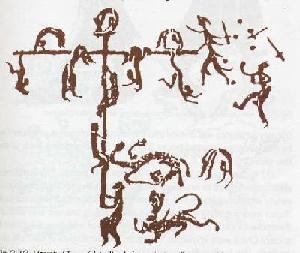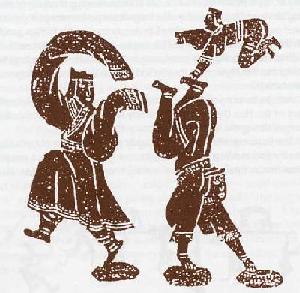Chinese people made outstanding contributions to world civilization during the Han Dynasty (206BC-220AD). Emperor Wudi, the fifth ruler of the Han Dynasty, was a talented man with an affinity for variety shows. According toRecords of the Historyby Sima Qian, Emperor Wudi invited a number of foreigners to a sumptuous banquet in 108BC in order to extol the virtues of his empire's vast territory and abundant resource. The guests were presented beautiful gifts and entertained with variety shows featuring music and dance, acrobatics, wrestling, performances by men disguised as rare animals and wild animal acts. A point well worth mentioning is that envoys from Parthia (today's Iran) brought artists from Alexandria, Egypt, to China to perform at the banquet. Their performances included knife swallowing, fire spitting, man slaughtering and horsemanship. The magnificent performances and grand dinner party enabled Emperor Wudi to deeply impress his foreign guests with the power and prosperity of his empire. In addition, he successfully achieved his political goal of convincing countries in the Western Regions to enter into friendly ties with the Han and form an alliance against powerful Hun nomads.
Acrobatics as a performing art took shape and grew during the early years of the Han Dynasty, while variety arts centered on acrobatics emerged during the Eastern Han Dynasty (25-220).
The basic classification of the highly skilled art form of both Han Dynasty and modern acrobatics remains the same and is a unique phenomenon rarely seen in performing arts in other countries. Han Dynasty acrobatics were divided into the following categories as evidenced by wall paintings, painted bricks and stone carvings dating back to the Han period:
|

|
| Variety Show, a brick painting discovered in a Han tomb in Anqiu County, Shandong Province |
(1) Items requiring strength. In a narrow sense, this particular classification refers to wrestling which occupied an important position in variety arts during Han times. Han paintings and stone carvings not only depict men wrestling men, but also men battling animals and animals themselves locked in fierce combat. Professional wild animal fighters in ancient China were known asXiangren. Archeologists unearthed one particular Han tomb in Nanyang County, Henan Province, and discovered more than 20 stone carvings depictingXiangrenbattling bulls, tigers and rhinoceroses.Pole Balancingis another item that requires unusual strength. A painting unearthed in a Han tomb in Anqiu County, Shandong Province, shows 10 acrobats performing various stunts on a long pole held by a single man.
|

|
| Handstands, a stone carving dating to the Han Dynasty |
(2) Handstands. Performing handstands was an important component of Chinese acrobatics during the Han Dynasty and remains so even today. The skill requires extraordinary agility and proficiency at somersaulting techniques, as well as excellent flexibility. Numerous brick paintings and stone carvings depict Han acrobats performing handstands and headstands. The example shown here was found in the ancestral shrine of the Wu family in Jiaxiang County, Shandong Province.
